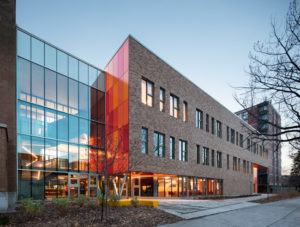Montréal school expansion harmoniously blends into existing building

Photo © Stéphane Brügger
Smith Vigeant Architects and BGLA | architecture + urban design in consortium completed the Christ-Roi Elementary School expansion, located in the Ahuntsic-Cartierville Borough in Montréal.
The expansion added three new floors including nine classrooms, kindergarten, daycare service, and gymnasium.
Creating a harmonious composition, the extension incorporates the principles of the existing building and redefines the school’s relationship with its context. On the street, a sculpted volumetry announces the new hall, and the social and active functions. On the courtyard side, transparency and colour are more expressed, offering a personalized character to the institution, respecting its initial pavilion.
The two buildings are built around a vast central staircase covered in natural light and the radiance of colours. The staircase ensures the new links with the existing school while providing socializing space. The entrance hall, by its size and opening, creates a transition space between the neighbourhood, daycare service, and schoolyard.
To have a harmonious implementation, the extension follows the existing building principles: a simple rectangular volume with a brick façade. The proportions of which are dictated by a typical class floor, of standard dimensions, with a central corridor.
Open and interactive place
The expansion’s ground floor is developed in a more open and dynamic way. It establishes functional and convivial links with the existing building, the schoolyard, the street, and the neighborhood. A series of subtractions sculpt the volume to define significant and functional places, namely: the new reception hall and its large exterior forecourt, the daycare service (connected to both the street and the schoolyard), plus the gymnasium, also asserting its presence in the neighbourhood and in the courtyard.
Connection and centrality
It is through the central hall that the new and old connect. Located in the center of the newly enlarged school, the hall acts as a hub for traffic and links between floors, between the neighbourhood, and the schoolyard.
Offering transparency between the reception area on the nearby Lajeunesse Street and the schoolyard, the hall provides a luminous common area, connecting the corridors of the old and the new. In addition to facilitating orientation within the new wing, this central hall assures a better understanding of the place and its environment.
Volumetry, materials, and active design
The façade on Lajeunesse Street affirms the institutional character of the building. To keep a coherent whole, a similar brick façade was chosen. The modulation of the façade marks three major entities of the project in the public space, namely: the new hall and the main entrance to the daycare service, as well as the gymnasium. The ground floor is deliberately more open on the new schoolyard, contributing also to a lively relation at the street level, thus defining a new and interactive public space.
The larger masonry volume, therefore, sculpts the school’s social and ‘active’ functions. Like subtractions in a more rigid volume, these functions – hall, daycare, gymnasium, stairs – are expressed in the public space and the courtyard, either in transparency or in colour.
On the schoolyard side, transparency and colour are more expressed, offering a personalized character to the institution and its active schoolyard. Aluminum panels in different shades of red and orange, create a link with the red colour of the existing doors and windows, but also with the surrounding context, which contains ‘plexes’ in brick of different shades of clay.


